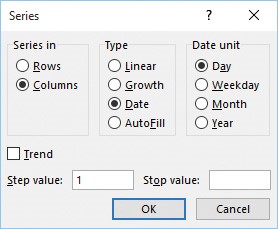Objective 2.1: Apply Custom Data Formats and Validation (δείγμα)
- 2.1.1. Create custom data formats
- 2.1.2. Populate cells by using advanced Fill Series options
- 2.1.3. Configure data validation
OBJECTIVE 2.1: Contents
2.1.2. Populate cells by using advanced Fill Series options
Worksheets often use text series (such as January, February, March; or Sunday, Monday, Tuesday) and numeric series (such as 1, 3, 5; or 2016, 2017, 2018). Instead of entering these series manually, you can create them automatically by using the Auto Fill feature. That is, you enter and select the first couple of values in the series, drag the fill handle over the range you want to fill, and then click Fill Series in the AutoFill Options list.
Instead of using the fill handle to create a series, you can use the Series command to gain more control over the process. By using the Series command, you can specify a direction for the fill (rows or columns); a step value (the value by which each item in the series is changed to produce the next item); a stop value (the value at which Excel should terminate the series); whether you want the series to extend the trend of the initial values; the date units (such as day or month) for a date series; and the series type, which can be one of the following four values:
![]() Linear This
option finds the next series value by adding the step value to (or subtracting the step value from) the preceding value in the series.
Linear This
option finds the next series value by adding the step value to (or subtracting the step value from) the preceding value in the series.
![]() Growth This
option finds the next series value by multiplying the preceding value by the step value.
Growth This
option finds the next series value by multiplying the preceding value by the step value.
![]() Date This
option creates a series of dates based on the option you select in the Date Unit group (Day, Weekday, Month, or Year).
Date This
option creates a series of dates based on the option you select in the Date Unit group (Day, Weekday, Month, or Year).
![]() AutoFill This
option works much like the fill handle. You can use it to extend a numeric pattern or a text series (for example, Qtr1, Qtr2, Qtr3).
AutoFill This
option works much like the fill handle. You can use it to extend a numeric pattern or a text series (for example, Qtr1, Qtr2, Qtr3).
To populate cells by using the Fill Series command
1. Enter the starting value in the first cell you want to use for the series. If you want to create a series out of a particular pattern (such as 2, 4, 6, and so on), fill in enough cells to define the pattern.
2. Select the entire range you want to fill.
3. On the Home tab, in the Editing group, click Fill, and then click Series to open the Series dialog box.

In the Series dialog box, specify the type of series you want to use to fill the cells
4. Do either of the following to create the series, starting from the active cell:
• Click Rows to create the series in rows.
• Click Columns to create the series in columns.
5. In the Type group, click the type of series you want.
6. Do any of the following:
• If you selected the Date type, click an option in the Date Unit group.
• If you selected the Linear or Growth type and want to extend a series trend, select the Trend check box.
• If you selected a Linear, Growth, or Date series type, enter a number in the Step value box. This number is what Excel uses to generate the next value in the series.
• To place a limit on the series, enter a number in the Stop value box.
7. Click OK to fill in the series and return to the worksheet.
